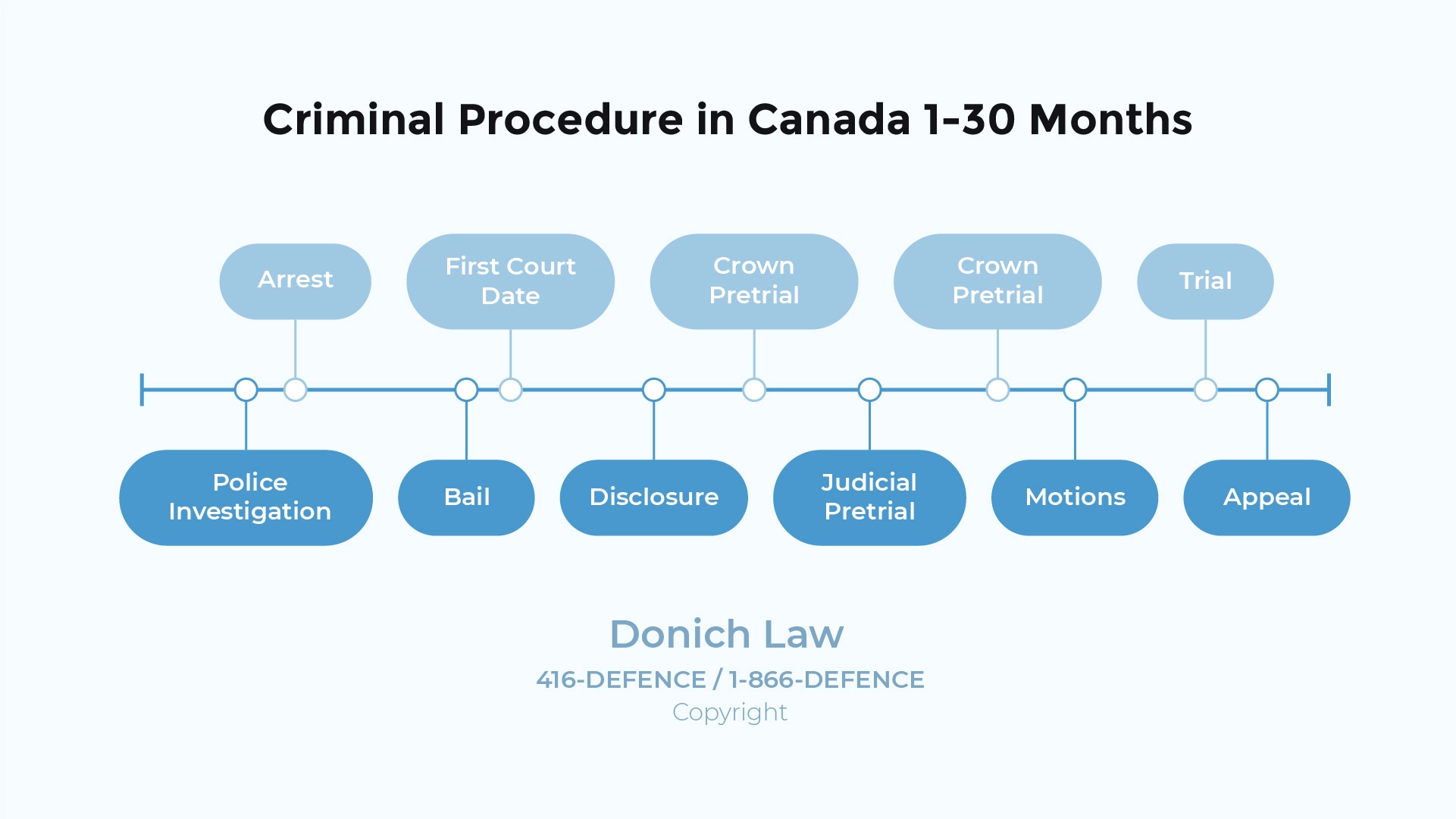
importing drugs and weapons
Frequently Asked Questions
Importing Offences in Canada
As mentioned, there are a few different importing offences, such as importing drugs, firearms and child pornography. Under section 103(1) of the Canadian Criminal Code, every person commits an offence who imports or exports either a prohibited firearm, a restricted firearm, a non-restricted firearm or any component or part designed exclusively for use in an automatic firearm. The last part however has an exception if the manufacturing or assembly of an automatic firearm is authorized by the Firearms Act or another Act of Parliament. The punishment here is imprisonment for a term not exceeding 10 years, with a minimum punishment of three to five years.
Further, under section 163.1(3) of the Criminal Code, every person who imports or exports (among other actions) any child pornography is guilty of an indictable offence and liable to imprisonment for a term of not more than 14 years and to a minimum punishment of imprisonment for a term of one year. The definition of the term “child pornography” is provided under subsection (1) of this provision. This offence is one classified in Canadian law as an offence “tending to corrupt morals.”

- CP24: Civil Sexual Assault Lawsuit at St. Michael’s in Toronto.
- Global News Morning Show: Sentencing Arguments in Assault case of Dafonte Miller.
- Breakfast Television: Role of Mental Health in Court Proceedings.
- Global News National: Bruce McArthur will not serve consecutive sentences.
- CBC Radio: Interview with Mayor John Tory and Jordan Donich on CBC Radio.
- CTV News National: Handgun ban supported by majority of Canadians: Nanos survey.
- Global News: How difficult is it to get a legal handgun in Canada.
- CP24: Sentencing Hearing for Chair Girl.


What is the Penalty for Importing Drugs into Canada?
When dealing with the importation of drugs into Canada, we look to the Controlled Drugs and Substances Act (the “CDSA”), and more specifically, section 6(1). This section reiterates that other than the authorized by the regulations enacted under the CDSA, no person shall import or export any substances listed in schedules I, II, III, IV, V or VI of the CDSA. These substances can range from opium to codeine, to barbital or even Hydriodic acid.
An important part here is that there are different penalties for different drugs based on the schedule they have been categorized under in the CDSA. The penalties regarding the import or export of drugs is noted under section 6(3) of the CDSA. Here, imprisonment can range from a term not exceeding one year, all the way to a term of imprisonment for life. This is reflected in the Alberta Court of Appeal case of R. v. Overacker (2005), where the Crown appealed an eight-year prison sentence, imposed on the respondent after he plead guilty to importing cocaine into Canada. The court stated “there would be no cocaine problem in Canada without the cocaine importer, acting as principal or as a courier”, and concluded with by substituting a sentence of imprisonment for 12 years instead.
Can I Legally Import Guns into Canada?
In order to determine whether a gun can be imported into or exported from Canada, one must look to the Firearms Act. Section 35(1) deals with authorized exportation and importation. Here, a non-resident who doesn’t have a licence, may import a firearm that is not a prohibited one, but there must be certain conditions present at the time of the importation. For example, the non-resident must be eighteen years old or older, they must declare the firearms to a customs officer and in the case of a restricted firearm, they must produce authorization to transport it. The customs officer must also confirm all of this in order to allow it.
This is reflected in case law as well. In the Alberta Court of Queen’s Bench (as it was then) case of R. v. Luft (1996), the judge stated that because the accused was instructed to declare the firearms at customs, there was no mens rea (guilty mind) on the part of the accused to actually commit the offence. This showcases how integral the declaration and adherence to section 35(1) of the Firearms Act is.
Stages of the Criminal Justice System

How will a Conviction for Importing Drugs or Guns affect me?
In general, a conviction for importing drugs or firearms into Canada results in a sentencing handed down by the court with imprisonment based on the particulars. However, there is of course the negative stigma and societal abandonments that accompany this. For example, individuals will often face discrimination from friends, family and the community, resulting in a prejudiced tone and behaviour made towards them.
Possibly the most negative effect is the result of a criminal record, the effects of which are likely to stay with a person for the rest of their life. Further, a criminal record will likely pose challenges during the job search process. It has become more and more common, if not a standard practice, for employers to conduct background checks as a part of their hiring process, which requires filing for a criminal record check. Of course, while the actual hiring process should consider an array of qualities, it is of no surprise that a criminal record can considerably impact the final decision. Similarly, travelling would also be affected, as many countries, such as the US, would be hesitate or weary to let someone in when there is a criminal record on file. This is especially true for importing and exporting offences.
In addition, if an offender was caught importing guns, the court may make a mandatory weapons prohibition order under section 109 of the Criminal Code. There may also be forfeiture orders related to proceeds of the importing/exporting, or the product imported or exported itself. Lastly, a DNA order may also be made, although it is discretionary as well for both guns and drug importing.
Consequences of a Criminal Record
Can I be Charged with Importing Child Pornography into Canada?
Yes. As noted above, this would invoke section 163.1(3) of the Criminal Code. This offence is for the distribution of child pornography which includes importing. Typically, such an offence is carried out online, as images or videos are typically “imported” through the internet. This means that even if the data is sent online, from another country into Canada, the individual may still be guilty of importing child pornography. Similarly, if an individual had child pornography material in physical form (i.e., photos or a story) and they brought that material over the border into Canada, that would also be considered a crime.
This charge is an indictable offence with a maximum punishment upon conviction of a 14-year prison term and a minimum punishment of one year in jail. However, section 163.1(6) of the Criminal Code states that you cannot be convicted if you had a “legitimate purpose” for the child pornography, related to the administration of justice or to science, medicine, education or art.
For example, in R. v. Katigbak (2011), the Supreme Court of Canada looked at the accused’s act of collecting child pornography based on his subjective belief that his art exhibit was enough to satisfy the legitimate purpose test, under section 163.1(6). The SCC ordered a new trial and reasoned that the [c]ourt of Appeal erred in two respects. First, it erred in its interpretation of the defence by relying on a community standard to determine if the risk of harm posed was “undue” within the meaning of s. 163.1(6)(b)” …and second, it “substituted its own views on the harm posed by Mr. Katigbak for those of the trial judge.”
Law Newbie is a free AI research assistant that can help you safely answer questions about criminal law.
Recent Cases
R v. Grant-Stuart, 2022 ONCA 801
In the Ontario Court of Appeal case of R. v. Grant-Stuart, the appellant and his brother were charged with importing cocaine and possessing it for the purpose of trafficking. The charges arose out of the seizure of 48 kilograms of cocaine, concealed in a container of foodstuffs, that was imported into Canada from Guyana (at para 2). His co-accused was acquitted but he was found guilty on both charges and sentenced to nine years’ imprisonment, which he appealed.
There were several shipments sent over from Guyana. In the midst of the fourth shipment, the Canadian Border Services Agency (the CBSA) inspected the contents and discovered the cocaine – the value of which was almost $1 million. The appellant had argued that he ran a legitimate food importing business, however, the Crown challenged this by bringing to light the inconsistency between his claimed income and his ability to purchase inventory.
Ultimately, the Court of Appeal held that the trial judge did not err in administering the law or in principle as she properly identified that deterrence was the key component for a sentence of drug importing cases. For these reasons the conviction and sentence appeals were dismissed (at para 31).
R. v. Khera, 2021 ONSC 2545
In the Ontario Superior Court of Justice case of R. v. Khera, the accused was a commercial truck driver caught at the US-Canada border, importing drugs. The accused entered Canada with his large tractor-trailer vehicle by crossing the Detroit/Michigan borders to Canada. The contents of his truck were bound for Mississauga, Ontario. After a routine check of his truck, there was an anomaly – 179.2 kilos of opium poppy heads, pods and stalks.
“The opium poppy is a Schedule 1 drug under the Controlled Drugs and Substances Act, as are its preparations and derivatives including opium, codeine, heroin and oxycodone” (at para 9). Schedule 1 drugs are known to be the most seriously controlled and monitored. The seriousness of the offence led the court to direct considerations of the fundamental principal of sentencing, which is proportionality. The court then weighed both the aggravating and mitigating factors.
The court ultimately ruled that the fit and proper sentence is two years imprisonment for the accused. Additionally, the court also issued that there would be a section 109 weapons prohibition order for 10 years on the accused.
R. v. Tello, 2023 ONCA 335
In the recent Ontario Court of Appeal case of R. v. Tello, an RCMP investigation resulted in the uncovering of a large-scale drug importing crime. The appellant was charged with several offences, including conspiracy to import at 1,000 kilograms of cocaine. A jury found the appellant guilty of all offences. He was subsequently sentenced to 15 years’ imprisonment. The appellant appealed his convictions and sentence (at para 2).
In 2013, the RCMP commenced an investigation called “Project Harrington” which had the aim of arresting those importing cocaine into Canada through Nova Scotia. An undercover officer infiltrated a group, leading to appellants arrest. In their plans, the co-conspirators had discussed the importation of “massive” quantities of cocaine – at one point even mentioning the possibility of importing up to over 13,000 kilograms. Evidence at trial established that the would-be cocaine importers would have profited $42,500 per kilogram or up to $42.5 million in total.
The court then compared the case at bar to R. v. Russo, (1998), stating how there was a “destructive nature” specifically with cocaine. In Russo, Doherty JA reiterated that the accused (in Russo) “contemplated a large- scale commercial transaction in a deadly substance. While ultimately no profit was made, there can be no doubt that profit was the motive. These respondents were prepared to do significant damage to others so that they could make money.” (at para 93). This is the thought process the Court of Appeal reflected as well and the appeal from conviction was dismissed.












